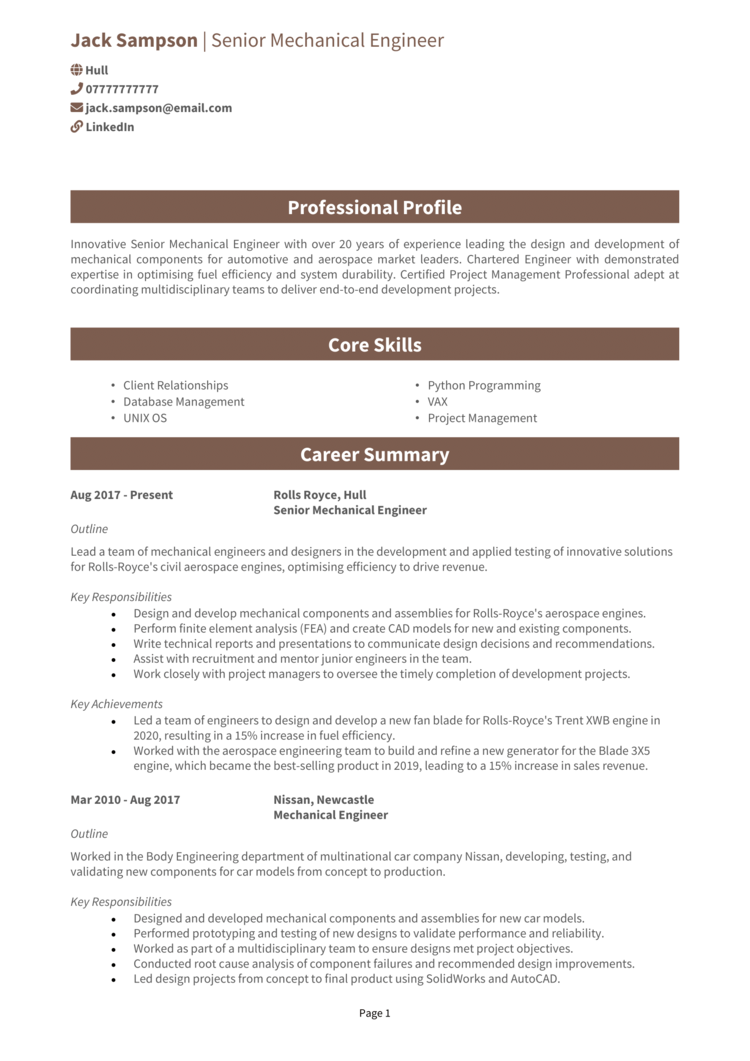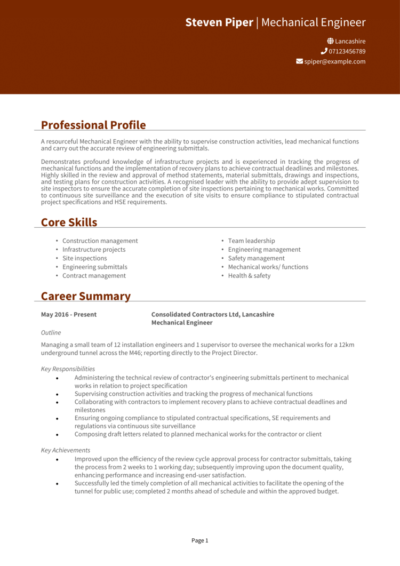Do you have the knack for turning complex problems into well-oiled solutions? Or maybe you just really, really enjoy solving what others call ‘impossible’?
As a Mechanical Engineer, you transform concepts into working systems and ensure machines hum along smoothly. But before you can get hands-on with your next big project, you’ll need a CV that doesn’t break down under recruiter scrutiny. No duct tape fixes allowed!
This guide, complete with some Mechanical Engineer CV examples, will help you craft an application that gets the attention of hiring managers and bags you plenty of interviews for high-paying jobs.
Mechanical Engineer CV

Junior Mechanical Engineer CV

Mechanical Project Engineer CV

Senior Mechanical Engineer CV

How to write your Mechanical Engineer CV
Learn how to create your own interview-winning Mechanical Engineer CV with this simple step-by-step guide.
A Mechanical Engineer CV needs to highlight more than just your qualifications – it’s your opportunity to showcase your technical prowess and ability to deliver tangible results. Recruiters want to see evidence of your design skills, analytical thinking, and project management experience.
This guide will teach you to write a CV that demonstrates your expertise, highlights your achievements, and secures you a role where you can bring your engineering ideas to life
Mechanical Engineer CV structure


Your CV should be as precise as a CAD drawing – no wonky lines or missing dimensions allowed. A clear structure allows recruiters to quickly see why you’re the right candidate for the job: and just like a machine, every part needs to fit together perfectly.
Here’s how to structure your Mechanical Engineer CV:
- Name and contact details – Display personal details prominently at the top for easy access. Whether or not to include a photo depends entirely on your preference.
- Profile – Open with a succinct summary that highlights your engineering expertise, major projects, and technical skills.
- Core skills – Present your key abilities, such as CAD design, prototyping, and mechanical systems analysis, in a brief list of bullet points.
- Work experience – Detail your professional history in reverse chronological order, focusing on responsibilities and outcomes.
- Education – Detail your academic history and training that makes you the right fit.
- Additional info – This optional section can include professional memberships, awards, or even hobbies that align with your problem-solving mindset.
Mechanical Engineer CV format


Your CV should run as smoothly as a well-lubricated engine – anything clunky or chaotic will stall your chances. Even the most impressive qualifications can fall flat if their CV isn’t professionally presented, and full of easily-avoidable mistakes.
Here’s how to format your Mechanical Engineer CV:
- Bullet points – Condense your responsibilities and achievements into short, impactful lines: it’ll make for a nicer layout.
- Divide sections – Clear headings and logical spacing ensure recruiters can easily find key information throughout your CV.
- Use a clean font – Choose a readable and professional font that enhances clarity and avoids distractions.
- Keep it the right length – 2 pages provide enough space to showcase your expertise without adding unnecessary bulk.
Mechanical Engineer CV profile


Your profile is your elevator pitch – or, in engineering terms, your brief specifications – showcasing exactly why your skills and qualifications make you the perfect fit.
Mechanical Engineer CV profile examples
Profile 1
Proficient Mechanical Engineer with five years of experience in designing and optimising mechanical systems for manufacturing industries. Skilled in using SolidWorks, AutoCAD, and MATLAB to develop innovative solutions that enhance efficiency and reliability.
Profile 2
Organised Mechanical Engineer with three years of experience in the automotive sector, focusing on product development, prototyping, and testing. Adept at collaborating with cross-functional teams to deliver cost-effective designs that meet performance standards.
Profile 3
Experienced Mechanical Engineer with over eight years of expertise in industrial machinery design and maintenance. Skilled in finite element analysis (FEA), 3D modelling, and project management, with a proven record of delivering high-quality solutions under tight deadlines.
What to include in your Mechanical Engineer CV profile
Here are some tips on what to include in your Mechanical Engineer CV profile:
- Where you’ve worked – Specify which industries or organisations where you’ve applied your engineering skills.
- Your top qualifications – Highlight degrees in mechanical engineering or relevant certifications.
- Key skills – Make clear note of your key abilities like design, testing, and troubleshooting.
- Projects you’ve delivered – Reference key projects, such as product designs, system installations, or equipment upgrades.
- Technical expertise – Mention your familiarity with tools like AutoCAD, SolidWorks, or MATLAB.
Core skills section


Your core skills section is like a blueprint for recruiters – it gives them a quick overview of your technical abilities and what you bring to the table.
For Mechanical Engineers, this section should highlight design skills, analytical capabilities, and project management expertise. Tailor it to the role and industry you’re applying for.
Key skills for your Mechanical Engineer CV
- Computer-Aided Design (CAD) – Proficient in software like AutoCAD, SolidWorks, and CATIA for 2D and 3D modelling.
- Finite Element Analysis (FEA) – Expertise in analysing stress, heat transfer, and structural integrity.
- Product Development – Designing and testing prototypes to refine and finalise product designs.
- Maintenance Planning – Creating schedules and strategies for preventive and corrective maintenance.
- Thermodynamics – Applying principles of heat transfer and energy systems in engineering solutions.
- Equipment Installation – Overseeing the setup and testing of mechanical systems.
- Process Optimisation – Improving system efficiency through data analysis and redesign.
- Quality Assurance – Ensuring designs and products meet industry standards and specifications.
- Troubleshooting – Diagnosing and resolving mechanical issues in equipment and systems.
- Project Management – Coordinating resources, timelines, and teams to deliver projects on time and within budget.
How to highlight your work experience


Your work experience section is where you prove you’re not just designing solutions in theory – you’re actually making them work. Highlight your contributions to projects, the systems you’ve designed, and the results you’ve achieved.
List your roles in reverse chronological order, focusing on responsibilities and measurable outcomes.
How to make your past experience easy to read for employers

- Outline – Provide an overview of the company, your role, and the types of engineering projects you worked on.
- Responsibilities – Highlight tasks like design, testing, or process improvements. Use action verbs like “developed,” “designed,” or “optimised.”
- Achievements – Showcase measurable results, such as cost savings, increased efficiency, or successful project completions. Include figures wherever possible to add impact.
Work history examples for a Mechanical Engineer
Mechanical Engineer | Innovate Manufacturers Ltd
Outline
Designed and maintained mechanical systems for a manufacturing company, focusing on improving efficiency and reducing downtime. Delivered customised solutions that enhanced production processes.
Responsibilities
- Developed detailed mechanical designs and 3D models using SolidWorks and AutoCAD.
- Conducted performance testing and implemented improvements to optimise system functionality.
- Collaborated with production teams to integrate new systems seamlessly.
- Prepared technical documentation and manuals for newly installed machinery.
- Monitored equipment performance and recommended maintenance schedules to reduce downtime.
Achievements
- Reduced system downtime by 20 percent through optimised maintenance protocols.
- Delivered a conveyor system redesign that improved production efficiency by 15 percent.
- Received recognition for developing a cost-effective solution that saved £50K annually.
Mechanical Engineer | AutoMotion Technologies
Outline
Worked as part of the product development team for an automotive supplier, designing components and overseeing their testing and integration. Focused on ensuring safety and performance standards.
Responsibilities
- Designed and prototyped mechanical components using CATIA and SolidWorks.
- Conducted finite element analysis (FEA) to ensure durability and compliance with safety regulations.
- Coordinated with suppliers to source high-quality materials within budget.
- Supervised testing and validation of components to meet industry standards.
- Prepared project reports and presentations for stakeholders and management.
Achievements
- Reduced component production costs by 10 percent through material optimisation.
- Improved product lifecycle by 25 percent with enhanced design techniques.
- Successfully delivered six new product designs on schedule within one year.
Mechanical Engineer | Industry Engineering Solutions
Outline
Managed the design and implementation of mechanical systems for industrial facilities, focusing on reliability, energy efficiency, and cost-effectiveness. Led teams to deliver projects on time and within budget.
Responsibilities
- Developed and implemented mechanical designs for industrial machinery using AutoCAD and Revit.
- Performed energy audits to identify and implement efficiency improvements.
- Led cross-functional teams in the installation and testing of new systems.
- Provided technical training to operators and maintenance staff for system upkeep.
- Ensured compliance with health, safety, and environmental standards in all projects.
Achievements
- Increased energy efficiency by 30 percent through system redesigns and upgrades.
- Reduced project costs by 15 percent by streamlining procurement and construction processes.
- Completed a large-scale project two months ahead of schedule, saving £200K in costs.
Education section


Your education section is the essential foundation of your engineering career – like a solid baseplate for your design. Include degrees, certifications, and any relevant courses.
List your qualifications in reverse chronological order, starting with the most recent.
Qualifications recruiters look for in a Mechanical Engineer
- Bachelor’s Degree in Mechanical Engineering – Foundational knowledge of engineering principles, materials, and mechanics.
- Certified SolidWorks Professional (CSWP) – Certification in advanced 3D modelling and design.
- Lean Six Sigma Green Belt Certification – Expertise in improving efficiency and reducing waste in processes.
- FEA Certification – Training in finite element analysis for evaluating structural performance.
- Project Management Professional (PMP) – Skills in managing engineering projects and resources.





